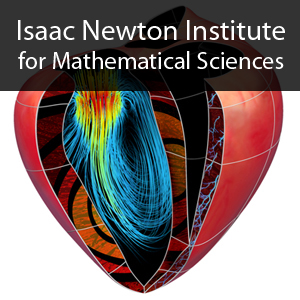Development of a virtual heart - Part ll
Duration: 14 mins 38 secs
Share this media item:
Embed this media item:
Embed this media item:
About this item

| Description: |
Zhang, H (Manchester)
Monday 20 July 2009, 14:45-15:00 |
|---|
| Created: | 2009-07-22 17:01 | ||
|---|---|---|---|
| Collection: | Cardiac Physiome Project | ||
| Publisher: | Isaac Newton Institute | ||
| Copyright: | Zhang, H (Manchester) | ||
| Language: | eng (English) | ||
| Credits: |
|
||
| Abstract: | Virtual tissue engineering of cardiac electrical activity requires detailed descriptions of local cell properties – their action potential (AP) mechanisms, local intercellular coupling, spatial heterogeneities, and their spatial and geometric relations. Over the last decade, we have developed a new family of single cell AP models for all distinctive regions of the rabbit heart. These single cell models include the centre and periphery of the sinoatrial node (SAN) (1), the right atrium (RA) and left atrium (LA) (2), crista terminalis and pectinate muscles (3), Bachmann’s bundle, pulmonary vein and coronary sinus (4), fast and slow pathways of the atrioventricular node (AN and N of the AVN) and His bundle (NH) (5), Purkinje fibers (PF), endocardial (Endo), middle (M) and epicardial (Epi) layers of the left ventricle (LV) (6). These single cell models were based on and validated against experimental data. Using these single cell models, we have developed a 1D model for the whole heart conduction system that incorporates regional differences in both cellular electrical properties and intercellular electrical coupling among major distinctive regions of the rabbit heart, including the SAN, atrium muscle, AVN, PF and ventricle. The model reproduces the normal activation sequence of the heart with an endogenous SAN driven rate of ~180 beats/min. The activation is first initiated in the centre of the SAN. Once initiated, it propagates towards the periphery of the atrium and then to the AVN via the rapid conduction pathway of the crista terminalis. The AVN then transmits the excitation to the PF and then to the ventricle. The AP conduction velocities ranging from ~0.1 m/s in the SAN to 1.5 m/s in the PF, which are consistent with experimental data. The whole heart model also produces a pseudo-ECG with intervals (R-R=333 ms, Q-T=214 ms, P-R=85 ms) that fall in the range seen in isolated Langendorff perfused rabbit heart. Simulated effect of acetylcholine (ACh), a neurotransmitter released from vagal nerves upon stimulation, is also consistent with the measurement from Langendorff perfused rabbit heart. |
|---|---|
Available Formats
| Format | Quality | Bitrate | Size | |||
|---|---|---|---|---|---|---|
| MPEG-4 Video | 480x360 | 1.82 Mbits/sec | 200.60 MB | View | Download | |
| WebM | 450x360 | 759.03 kbits/sec | 80.61 MB | View | Download | |
| Flash Video | 480x360 | 803.71 kbits/sec | 85.75 MB | View | Download | |
| iPod Video | 320x240 | 504.78 kbits/sec | 53.86 MB | View | Download | |
| QuickTime | 480x360 | 506.98 kbits/sec | 54.09 MB | View | Download | |
| MP3 | 44100 Hz | 125.0 kbits/sec | 13.14 MB | Listen | Download | |
| Windows Media Video | 477.7 kbits/sec | 50.97 MB | View | Download | ||
| Auto * | (Allows browser to choose a format it supports) | |||||

